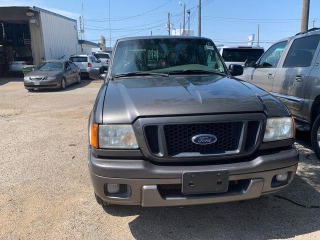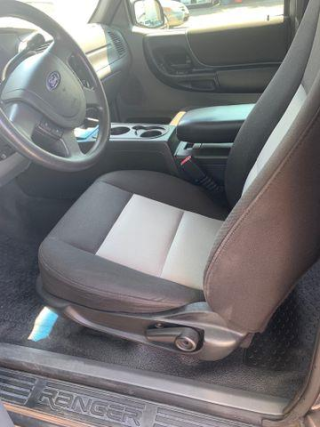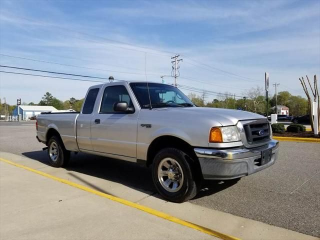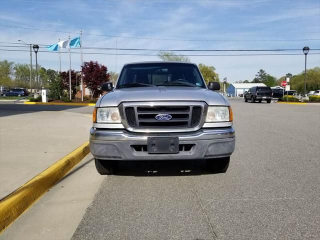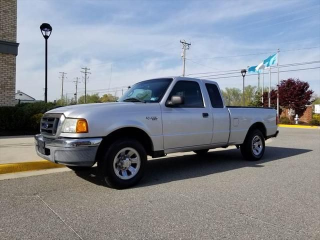The Good
The 2004 Ford Ranger offers several key advantages appealing to both emotional and practical buyers. Its compact size ensures excellent maneuverability and ease of parking, a practical boon for urban dwellers or those with tight spaces. Emotionally, it evokes a sense of rugged simplicity and dependability. Performance-wise, its available V6 engines provide decent power for its class, while its robust construction translates to impressive long-term reliability and a low cost of ownership. It's a practical choice for light hauling, off-road adventures, and budget-conscious truck enthusiasts seeking enduring value.
The Bad
While generally reliable, the 2004 Ford Ranger has some known weaknesses to watch out for. Common issues include rust, particularly on the frame and bed, engine problems with the 3.0L "Vulcan" V6 like head gasket failures, and automatic transmission woes such as delayed shifts or slippage. Suspension components, such as ball joints and control arm bushings, can wear out over time, leading to steering issues. Interior quality is basic and plastics can become brittle.
2004 Ford Ranger: Quick Overview
Here's a summary of key specifications for the 2004 Ford Ranger:
- Engine Options:
- 2.3L DOHC I4: 143 hp @ 5250 rpm, 154 lb-ft torque @ 3750 rpm
- 3.0L OHV "Vulcan" V6: 154 hp @ 5000 rpm, 180 lb-ft torque @ 3750 rpm
- 4.0L SOHC V6: 207 hp @ 5250 rpm, 238 lb-ft torque @ 3000 rpm
- Fuel Economy (EPA estimates, city/highway):
- 2.3L I4 (2WD, manual): 21/26 MPG
- 2.3L I4 (2WD, automatic): 19/24 MPG
- 3.0L V6 (2WD, manual/automatic): 16/22 MPG
- 3.0L V6 (4WD, manual/automatic): 15/19 MPG
- 4.0L V6 (2WD, manual/automatic): 15/20 MPG
- 4.0L V6 (4WD, manual/automatic): 14/19 MPG
- 0-60 MPH Times (approximate, varies by configuration):
- 2.3L I4: 9.5-10.5 seconds
- 3.0L V6: 9.0-10.0 seconds
- 4.0L V6: 7.5-8.5 seconds
- Towing Capacity (varies significantly by engine, transmission, and configuration):
- Typically ranges from 2,200 lbs (2.3L I4) to a maximum of 5,800 lbs (4.0L V6, properly equipped).
- Trim-Level Features:
- XL: Basic work truck. Manual windows and locks, AM/FM stereo, vinyl seats, steel wheels. Focus on utility and affordability.
- XLT: Adds comfort and convenience. Cloth seats, power windows and locks, air conditioning, CD player, chrome exterior accents, styled steel or alloy wheels.
- Edge (rebadged as FX4 Off-Road in some markets/later years, but 2004 still had Edge branding): Sportier appearance and capability. Unique interior trim, body-color bumpers, fog lights, upgraded wheels, and for 4x4 models, off-road suspension with heavier-duty shocks, skid plates, and a limited-slip differential. This trim offered a balance of daily driveability and weekend adventure readiness.
- FX4 Level II (optional package on FX4/Edge): Enhanced off-road capability with Bilstein shocks, Torsen limited-slip differential, specific alloy wheels, and more aggressive tires. This was the most capable off-road variant.
2004 Ford Ranger Specifications
Vehicle Information
| Year | 2004 |
| Make | Ford |
| Model | Ranger |
| Trim | - |
| Style | - |
| Type | Truck |
| Category | Small Pickup Truck |
Manufacturing Details
| Made In | United States |
| Manufacturing City | ST. PAUL |
Dimensions
| Doors | 2-Door |
| Curb Weight | 3094 pounds |
| Gross Vehicle Weight Rating | 4389 pounds |
| Overall Height | - |
| Overall Length | - |
| Overall Width | - |
| Wheelbase Length | - |
| Standard Seating | - |
Engine & Performance
| Engine | 3.0-L V-6 |
| Engine Size | 3L |
| Engine Cylinders | 6 |
| Transmission | 5-Speed Automatic |
| Transmission Type | Automatic |
| Transmission Speeds | 5-Speed |
| Drivetrain | Rear-Wheel Drive |
Additional Features
| Anti-Brake System | - |
| Steering Type | - |
Pricing
| Manufacturer Suggested Retail Price (MSRP) | $18,430 |
| Invoice Price | $16,698 |
| Delivery Charges | $620 |
Vehicle History Report
Specifications
History
Events
History Check
Check
Check
Check
Check
Listings
Recalls
Check
Analysis
What Problems Does the 2004 Ford Ranger Have?
Automatic transmission problems are also commonly reported, especially with the 5R55E unit. Owners often describe symptoms such as delayed engagement, harsh shifts, or complete failure to shift into certain gears, particularly reverse. These issues can often be attributed to solenoid pack failures or worn clutch packs.
Rust and corrosion are prevalent, especially in regions with harsh winters or coastal environments. Owners frequently report rust on the frame, suspension components, bed supports, and rocker panels. This is a critical point to inspect when considering a used Ranger, as extensive frame rust can compromise structural integrity.
Front suspension components, including lower ball joints and control arm bushings, are known wear items. Failure of these parts can lead to clunking noises, uneven tire wear, and poor handling. Steering column issues, such as a loose feeling or squeaks, are also occasionally noted.
As for recalls, the 2004 Ford Ranger has had several. A prominent recall (NHTSA Campaign ID: 05V334000) addressed potential defects in the cruise control deactivation switch, which could lead to an electrical short and even engine compartment fires. Another significant recall (NHTSA Campaign ID: 15V340000) involved the passenger side frontal air bag inflator, which could rupture in a crash and propel metal fragments, posing a serious injury risk. It's crucial for any potential buyer to check if all applicable recalls have been addressed by a Ford dealership. Other minor recalls existed for various components, but the cruise control switch and airbag inflator were among the most critical.
Long-term reliability is generally good for well-maintained Rangers, but these specific areas require diligence from owners and prospective buyers. Regular fluid changes, especially for the transmission, and prompt attention to engine noises can mitigate some of these common issues.
How long will the 2004 Ford Ranger last?
What Technology & Safety Features are Included?
Entertainment:
The standard entertainment system typically included an AM/FM stereo with a two-speaker setup. Higher trims (XLT, Edge/FX4) and optional packages could include a single-CD player, and sometimes a premium audio system with four speakers. Auxiliary input jacks were not standard or widely available in this era, reflecting the technology of the time. The emphasis was on functional audio rather than extensive multimedia connectivity.
Built-in Tech & Driver-Assistance:
Beyond fundamental gauges for speed, fuel, and engine temperature, the built-in tech was minimal. Driver-assistance features were largely absent by modern standards. You would find power steering and optional anti-lock brakes (ABS) on the rear wheels as standard or optional, with four-wheel ABS available on certain configurations. Cruise control was an optional convenience feature, primarily offered on XLT and Edge/FX4 trims. Remote keyless entry was also an available option, providing a slight convenience upgrade. Traction control and stability control systems were generally not offered on the Ranger in 2004, aligning with its utilitarian market position and compact truck segment.
Safety Features:
Standard safety features included:
- Driver and front passenger airbags.
- Height-adjustable front shoulder belts.
- Seat belt pretensioners.
- Four-wheel Anti-lock Braking System (ABS) - typically standard on 4x4 and V6 models.
Crash-Test Ratings (NHTSA - National Highway Traffic Safety Administration):
The 2004 Ford Ranger generally received decent but not outstanding crash-test ratings for its class at the time.
- Frontal Impact (Driver): 4 out of 5 stars
- Frontal Impact (Passenger): 3 out of 5 stars
- Side Impact (Driver): 4 out of 5 stars
- Side Impact (Rear Passenger): 4 out of 5 stars
- Rollover Resistance: 3 out of 5 stars (for 2WD models) or 2 out of 5 stars (for 4WD models), which is typical for a truck of its ride height and type.
What Colors Options are Available?
2004 Ford Ranger Prices and Market Value
Today, in the used market, prices for a 2004 Ford Ranger vary significantly based on condition, mileage, engine, drivetrain (2WD/4WD), and geographic location. Expect to find prices ranging from as low as $2,000 to $3,000 for high-mileage examples with cosmetic or minor mechanical issues, up to $8,000 to $12,000+ for exceptionally clean, low-mileage 4x4 models, especially those with the 4.0L V6 or FX4 Level II package.
Depreciation for the Ranger was significant in its early years, like most vehicles, but it has largely stabilized, and in some cases, appreciated for well-preserved examples due to its cult following and the scarcity of compact trucks. Factors affecting current resale value include the overall physical condition (minimal rust is a huge plus), complete maintenance records, 4x4 capability, and the robust 4.0L V6 engine. Low mileage also commands a premium.
2004 Ford Ranger Cost of Ownership
Maintenance is straightforward and relatively inexpensive, as parts are widely available and many common repairs can be tackled by a competent DIY mechanic or independent shop. Long-term ownership costs are kept in check by the Ranger's inherent durability, though major issues like head gasket failure on the 3.0L or timing chain guides on the 4.0L can be costly if they occur. Overall, its simplicity and widespread parts availability make it an affordable truck to maintain over its long lifespan.
2004 Ford Ranger Fuel Efficiency
2004 Ford Ranger Safety Rating
NHTSA
IIHS
2004 Ford Ranger Insurance
reasonable repair costs.
How Does the 2004 Ford Ranger Compare to Other Truck?
Performance:
- Against Chevy S-10/GMC Sonoma: The Ranger's 4.0L V6 (207 hp) generally outperformed the S-10's strongest engine, the 4.3L V6 (typically 190 hp). Both offered comparable towing capacities in their top configurations.
- Against Toyota Tacoma: The Ranger's 4.0L V6 was competitive with the Tacoma's 3.4L V6 (190 hp). The Tacoma was often perceived as slightly more refined but with similar practical performance.
- Against Nissan Frontier: The Ranger's 4.0L V6 edged out the Frontier's 3.3L V6 (180 hp) in raw power, though both offered good capability.
Features:
All these compact trucks offered similar levels of basic features, with options for power accessories, CD players, and air conditioning on higher trims. The Ranger, S-10, and Frontier were generally more spartan, while the Tacoma often had a slightly more "upscale" feel to its interior materials and available options for the time. Off-road packages like the Ranger's FX4 were competitive with offerings from Toyota (TRD) and Nissan.
Reliability:
- Toyota Tacoma: Widely regarded as the benchmark for reliability in this class, often cited as having fewer common major issues than its domestic rivals, though not immune to frame rust in specific generations.
- Ford Ranger: Good long-term reliability for its I4 and 4.0L V6 engines (with attention to timing chain guides), but the 3.0L V6 was prone to head gasket issues, and transmissions could be problematic. Frame rust was also a common concern.
- Chevy S-10/GMC Sonoma: Known for decent reliability but also had common issues like intake manifold gaskets, fuel pump failures, and electrical gremlins.
- Nissan Frontier: Generally reliable, though some earlier models had issues with head gaskets or intake manifolds, similar to the S-10.
Price:
New, the Ranger was often competitively priced, usually falling between the more budget-friendly S-10 and the often pricier Tacoma. On the used market today, the Toyota Tacoma typically commands a significant premium due to its legendary reliability and strong resale value. The Ranger and S-10 are often more affordable used options, with the Ranger generally holding its value slightly better than the S-10/Sonoma due to its simpler design and lasting popularity.
Recommendations:
For maximum reliability and resale value, the Toyota Tacoma (particularly with the 3.4L V6) remains a strong alternative, though it will likely cost more. If budget is a primary concern and a slightly more robust, simple platform is desired, the 2004 Ford Ranger with the 2.3L I4 or 4.0L V6 (after a thorough inspection) is an excellent value. The Chevrolet S-10 is a similar alternative but often doesn't hold its value quite as well.
Final Verdict: Is the 2004 Ford Ranger a Good Truck?
It is absolutely worth buying, but under specific conditions. Focus on used models with the 2.3L I4 or the 4.0L V6 engine, as the 3.0L V6 is known for head gasket issues. Prioritize models with complete maintenance records, minimal frame rust (a critical inspection point), and ideally a manual transmission for maximum reliability and engagement. A 4x4 SuperCab with the 4.0L V6 and FX4 package represents a highly desirable and versatile choice. It's a durable workhorse that, with proper pre-purchase inspection and ongoing care, offers tremendous value and many more years of service.
